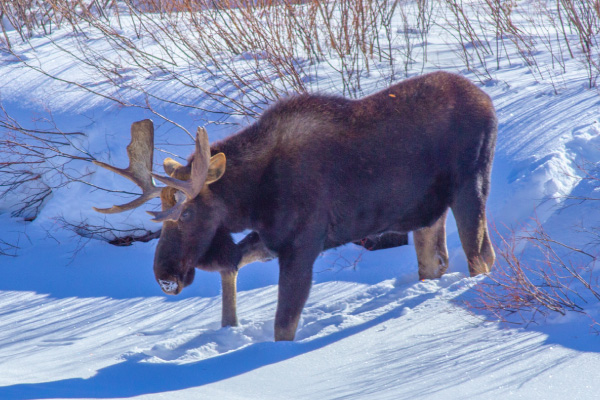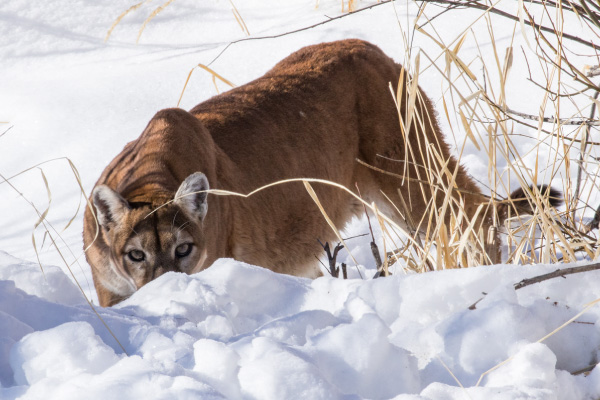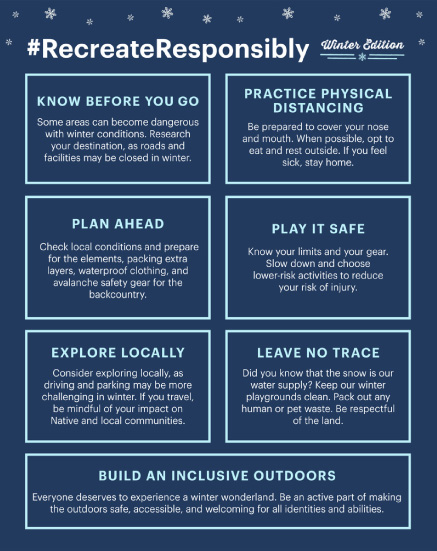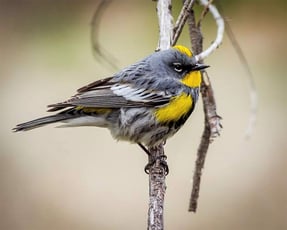Angling In Today's Climate
Fish ecology and streamflow data are changing in today’s climate. Whether it’s high runoff,...

Calling all backcountry enthusiasts! This winter has delivered less snow so far, along with COVID-19 which means that there is increased participation in the backcountry. Therefore, there is no time like the present to remind ourselves of who we are sharing the backcountry with, and what is required of us to keep on enjoying our wonderful backcountry adventures.
As an avid backcountry participant, myself, I want to have the presence of mind as to who’s out there with us trying to survive in winter conditions and how we can all, as a collective, improve upon and reduce our impact on wildlife in the backcountry.

Bighorn are generally not dangerous, but could be when provoked. A bigger problem is that the encounter may stress the sheep, which reduces their ability to obtain all the nutrition they need.
As we venture into the backcountry this season, pay close attention to the sights and sounds that are clues to other creatures all around who are likely very aware of our presence in their territory and habitat. The peace and quiet that we enjoy is their home, so we need to be respectful and appreciate the little things. Now that we are settling into the heart of winter, let’s redress our awareness.
First and foremost, be aware of avalanche danger and carry the appropriate equipment to be as prepared as possible in the backcountry. Please consult the Colorado Avalanche Information Center’s website for current avalanche conditions in your area www.avalanche.state.co.us.
Secondly, let’s practice patience, understanding and good etiquette. We want to establish a good rapport with fellow backcountry users. By whatever mode, foot, skis, snowboards, or snowmobiles, we all want to enjoy nature and what the backcountry has to offer. It is particularly necessary to understand who has the right-of-way. The animals come first, of course, it’s their habitat. We need to slow down and try to stay 30 yards away when we encounter wildlife, more to come on that later in the article. I have also found that when I demonstrate mutual respect for other backcountry users by yielding the right-of-way, it enhances my experience, especially with snowmobiles. Noise from over-snow vehicles is one of the biggest disrupters to wildlife and other backcountry enthusiasts. Especially in high-use areas where backcountry access is multi-use.

Moose are one of the most dangerous animals that people, particularly people with dogs, will encounter on a trail. Give them plenty of space. Colorado Parks and Wildlife officials caution that the large ungulates see dogs as a threat due to their similarities with wolves. Almost all incidents with aggressive moose involve dogs getting too close to the animal.
Whether it’s on forest service land, roads or trails we all need to be respectful of each other. In these days of COVID the forest service reminds people to wear a mask and remain socially distanced at trailheads and to abide by the posted signs and closures. The White River National Forest Service website also includes rules, fees, current closures, and seasonal allowances for year-round outdoor recreational enjoyment. Information regarding where and how you can travel in the White River National Forest including maps can be found at www.fs.usda.gov/detail/whiteriver.
Back to the creatures we share the backcountry with and who we want to protect. It is important to remember that the wildlife we may encounter in the backcountry are trying to use as little energy and burn as few calories as possible to survive the winter. The less we disturb them, the stronger their chance of survival. Those who we are most likely to see or hear in the backcountry are deer, elk, moose, bighorn sheep, mountain goats, coyotes, foxes, snowshoe hares, and ermine.
There is also an array of birds all around including large birds of prey and small owls, or low-flying ptarmigan who turn white in the winter with mottled darker feathers. The list of some of the avian species we may see are, golden eagles, bald eagles, goshawks, the Canada jay, Colorado bluebirds, and many more. You will see the smaller birds, like the squirrels, playing around without minding our presence much, but they are aware that we are there. 
Very few people have even seen a mountain lion. Lion attacks on people are rare. If you do encounter one, stand and face the animal. Make eye contact. Talk calmly and firmly to it. Stand tall, raise your arms, open your jacket if you're wearing one. Don't crouch, panic, or run. If the lion behaves aggressively, throw stones, branches.
Of course, mixed among these populations of wildlife there are predators. The main predator in Colorado in the winter is the mountain lion. Mountain lions usually avoid human contact but can be provoked and are dangerous. Remember that mountain lions are stealthy and often sneak up, unannounced on their prey. Stay aware of their presence and take note of posted signage if a mountain lion has been spotted in the area. Look for tracks, and If you ever encounter a mountain lion in the backcountry, or any time of year, make a lot of noise, appear as big as you can and establish as much space as possible between you and the mountain lion.
For a list of animal behavior traits when threatened please visit Colorado Parks and Wildlife’s website at www.cpw.state.co.us. It is also important to note that moose are not afraid of humans and can be provoked and will charge if they feel threatened, so please respect them and give them their space as well. Bighorn sheep and mountain goats will also charge if they feel threatened. 
We share the backcountry with so many wonderful creatures all of whom allow us to take part in our backcountry adventures without much objection, so let’s show our appreciation by respecting them and their habitat. Enjoy the wonders of nature even more so this season as more of us venture into the backcountry now and in the future.
Kathryn Middleton has lived in Vail since 1982, she is a member of the Eagle County Wildlife Roundtable and participates in the Education/Outreach Committee. She also serves on the board for the Mountain Valley Horse Rescue in McCoy, Colorado.
Kathryn Middleton has lived in Vail since 1982, she is a member of the Eagle County Community Wildlife Roundtable and participates in the Education/Outreach Committee. She also serves on the board for the Mountain Valley Horse Rescue in McCoy, Colorado.

Fish ecology and streamflow data are changing in today’s climate. Whether it’s high runoff,...

By Jen Prusse, District Wildlife Biologist, White River National Forest.*Photos by Rick Spitzer...